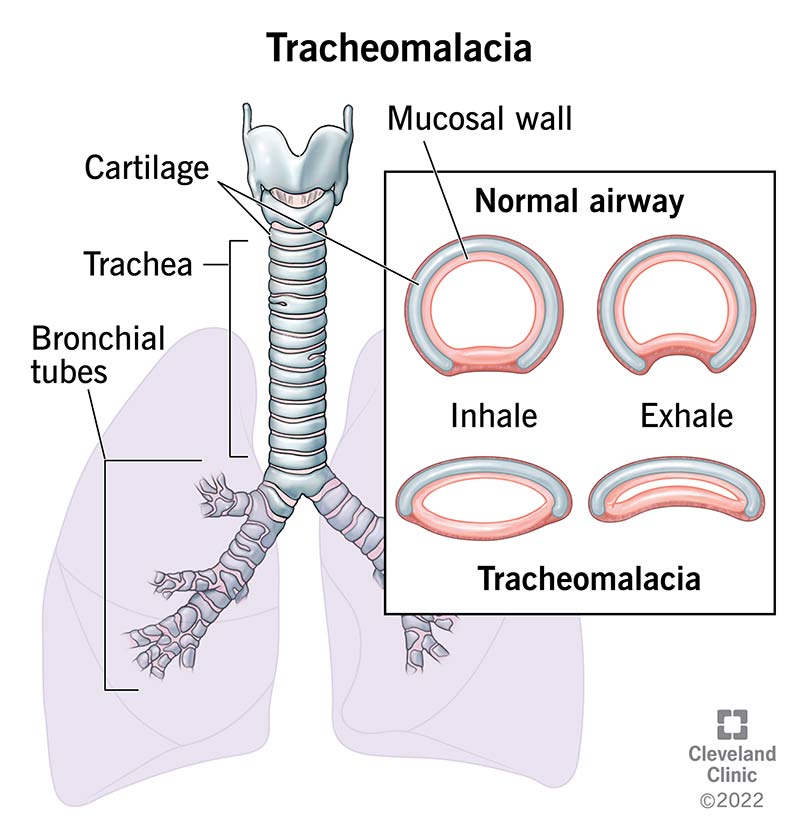Tracheomalacia happens when the cartilage in your windpipe is weak, floppy or damaged. It can result in symptoms like noisy breathing, shortness of breath and frequent respiratory infections. Treatments include physical therapy, medications and, rarely, surgery. Tracheomalacia most often affects babies, but anyone can develop it.
Advertisement
Cleveland Clinic is a non-profit academic medical center. Advertising on our site helps support our mission. We do not endorse non-Cleveland Clinic products or services. Policy

Tracheomalacia (TRAY-kee-oh-muh-LAY-shia) is when you have weak or floppy cartilage in your trachea (windpipe). The walls of your windpipe can collapse or fall in, causing symptoms like high-pitched breathing. It can also trap mucus in your lungs, making it difficult to clear them out. In severe cases, tracheomalacia may be life-threatening, but it’s curable with treatment.
Advertisement
Cleveland Clinic is a non-profit academic medical center. Advertising on our site helps support our mission. We do not endorse non-Cleveland Clinic products or services. Policy
Tracheomalacia usually affects newborns, but anyone can develop it. Babies born with the condition often develop symptoms when they’re 1 to 2 months old. Then, symptoms improve over the first three years of life. That’s because cartilage strengthens as your baby’s windpipe grows. But severe cases may need surgery.
There are two types of tracheomalacia:
Some people with tracheomalacia also have weak bronchi (the tubes that run from your windpipe to your lungs). Healthcare providers call this condition tracheobronchomalacia.
Congenital tracheomalacia is somewhat rare. Even so, it’s the most common birth defect affecting the windpipe. Approximately 1 in 2,100 children are born with the condition.
Acquired tracheomalacia (which can occur at any age) is also very uncommon.
Advertisement
The most common tracheomalacia symptom is high-pitched or noisy breathing (stridor). Other symptoms include:
Congenital tracheomalacia happens when the cartilage in your baby’s windpipe doesn’t develop the way it should. The walls of their windpipe are floppy instead of rigid.
Acquired tracheomalacia causes include:
Tracheomalacia may be associated with other conditions like:
Without treatment, tracheomalacia can cause:
A healthcare provider will do a physical exam and ask about your symptoms. They’ll also use laryngoscopy or bronchoscopy to look at your windpipe. To do this, they’ll guide a lighted scope with a camera down your throat.
Your healthcare provider may need to run more tests to diagnose tracheomalacia, like:
Healthcare providers can treat tracheomalacia with nonsurgical therapies, medications or surgery. What’s right for you depends on the extent of the condition.
The following treatments help keep your airways open and your lungs clear:
Healthcare providers use several different medications to treat tracheomalacia, including:
Advertisement
Severe tracheomalacia cases may need surgery. Some options include:
After treatment, most people with tracheomalacia go on to live healthy lives with no complications.
Treatment isn’t always necessary. Congenital tracheomalacia usually improves on its own by age 3. As your baby’s tracheal cartilage grows stronger, their symptoms will likely improve. But in some cases, your baby may need medication and/or surgery.
People with tracheomalacia need close monitoring if they develop respiratory infections. Even minor colds can cause complications. Your healthcare provider may recommend treatments or medications to manage your symptoms.
There’s nothing you can do to reduce your risk for tracheomalacia. But you can manage it with the help of your healthcare provider.
Schedule an appointment with your healthcare provider if your baby shows tracheomalacia symptoms. This includes things like frequent cough, noisy breathing or prolonged respiratory infections.
Advertisement
Tracheomalacia in adults can cause exercise intolerance and frequent respiratory infections. Tell your provider if you notice these things. They can confirm the diagnosis and recommend appropriate treatment.
If you have tracheomalacia, here are some questions you may want to ask:
The following conditions may be confused for tracheomalacia:
Learning that your baby has tracheomalacia can feel scary. Every cry, cough and whimper can put you on high alert. Or maybe you developed tracheomalacia yourself after an injury or illness. Tracheomalacia is usually mild, but even severe cases respond well to treatment. The best thing to do is stay in touch with your healthcare provider. Let them know about any new or worsening symptoms. They’ll let you know the extent of the condition and what type of treatment can help.
Advertisement
If you have conditions affecting your ears, nose and throat, you want experts you can trust. Cleveland Clinic’s otolaryngology specialists can help.

Last reviewed on 10/23/2024.
Learn more about the Health Library and our editorial process.